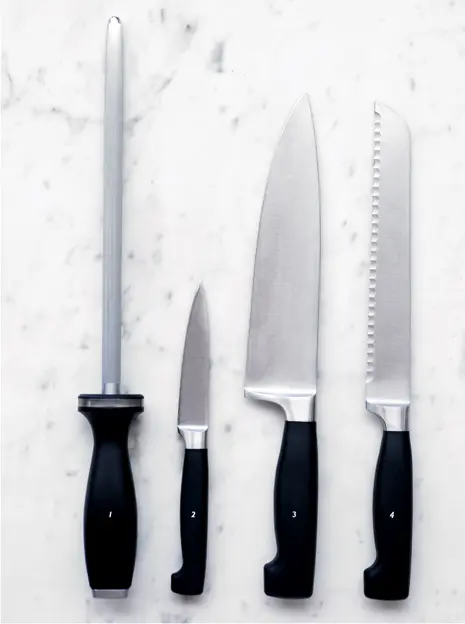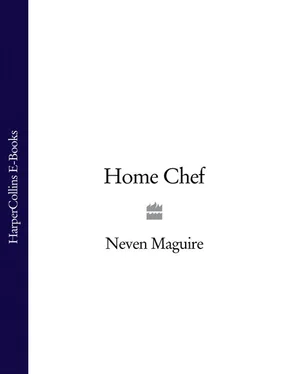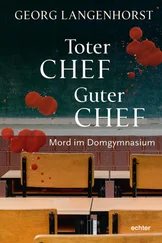One of the most important and widely used herbs, which comes in a variety of flavours. It has an intensely aromatic flavour, perfect in slow-cooked dishes, such as casseroles. Thyme is an ingredient of the bouquet garni, together with parsley and bay. A couple of sprigs of lemon thyme work well tucked into a whole salmon or trout, or try stuffing the cavity of a roast duck with orange thyme.
The first step to becoming a successful home chef is to keep your kitchen well equipped. You don’t need a lot of gear, but it makes sense to buy the best you can afford, then you know it will work for you and last a decent amount of time. Below left are the essential items that everyone should own, while the handy extras on the right are things I use less often. You might choose to buy only some of these, but I like to have them all to hand as they save me time and effort and help me to create stunning results.
1 large sharp knife (Cook’s knife)
1 small sharp knife (Paring knife)
1 bread knife
1 chef’s steel/knife sharpener
Can opener
2 chopping boards
Large non-stick frying pan
3 sizes of heavy-based saucepans
3 wooden spoons (or I use heatproof Mafter exoglass spoons)
Set of kitchen scales
Colander
Measuring jug
Metal hand whisk
Metal sieve
Slotted spoon
Fish slice
Potato masher
Swivel-style vegetable peeler
Box-style cheese grater
Pastry brush
Rolling pin
Roasting tin
Baking sheet
Casserole dish with lid
Tiered bamboo steamer
Cast-iron griddle pan (with metal handle)
Lemon zester
Lemon juicer
Tongs
Tweezers (for boning fish)
Potato ricer
Palette knife
Hand-held blender (my preference is Bamix)
Food processor
Kitchen scissors
Wok
Rubber spatula (heatproof)
Flour dredger
Chef’s blowtorch
Nylon sieve (for straining fruit, as some fruits react with metal)
Mortar and pestle
Measuring spoons
6 ramekins (try to build up a selection of different sizes)
6 dariole moulds (castle-shaped ramekins, narrower at one end)
Microplane grater (try to build up a selection of different blades)
Fluted round cutters (in various sizes)
Chef’s rings — 10cm (4in), 6cm (2½in) and 5cm (2in)
Disposable piping bags and nozzles
23cm (9in) loose-bottomed cake tin
Muffin tin and mini-muffin tin

Although you can get by with just the three knives listed on page 17, a full set of good knives is the best investment a keen cook can ever make. I recommend buying the most expensive set of knives you can possibly afford, because they should last for the rest of your life. I use Henckel knives, which are available from most good cookware shops, department stores and online.
When choosing a knife set, one of the most important factors to consider is the type of steel used to make the blades. The majority of knives are manufactured from a blend of high-carbon stainless steel that resists rust and corrosion and is dishwasher-proof. The ‘tang’ is the part of the knife where the metal is attached to the handle. The best knives will have a tang in which the metal visibly extends inside the handle, right to the end.
Good-quality knives are well balanced and feel good in the cook’s hand. Don’t be afraid to try holding them in the shop. They should be easy to handle and should feel solid, not flimsy. As a general rule, a good knife should feel like an extension of your own hand and should allow adequate space between the point where your fingers grip the knife and the surface on to which you are cutting. Once a month, we get someone to come into the restaurant to sharpen our knives, but a good butcher should be happy to do this for you – they normally have machines which will do a good job in seconds. You can also sharpen the knives yourself using a sharpening steel (see page 21 for instructions).
If you do decide to invest in a set of knives, the ones listed overleaf are the basic set with which I would begin. It’s also worth getting a knife block so that the knives can be kept in a safe place and are easily accessible. It helps prevent them from getting damaged or ruined.
1. Sharpening steel
2. Paring knif
3. Cook’s knife
4. Bread knife
This is the knife I use most often and which I could never do without in the kitchen. Its 26cm (10½ in) blade gives me the perfect balance between handle and blade, allowing excellent hold – perfect for chopping vegetables or herbs.
To ensure the perfect edge for carving meat, poultry, etc., choose a carving knife with a long, thin and slightly upturned blade.
An authentic butcher’s knife, designed especially to separate meat from bone. The blade is characteristically thin and curved, which ensures a thin cut. It can be used to remove the bones and cuts through meat very easily.
This knife has a long serrated blade of approximately 20cm (8in). A good one will slice bread without leaving a lot of crumbs.
A perfect knife for slicing roasts and dense meats such as large continental sausages. It has a comfortable handle and the scallops on the blade trap small air bubbles between the metal and the food, preventing the food from sticking to the blade and making it easy to slice meats very finely. The scalloped slicing knife is also good for cutting thicker slices with more precision. However, it is not suitable for carving meat on the bone – it’s too long and doesn’t have a point, so will feel very clumsy in this situation.
Despite its name, which suggests it is used for meat, this knife’s speciality is actually fish! Choose one with a thin, flexible blade for performing the most delicate kitchen operation: preparing perfect fillets. You’ll also need tweezers to remove the last few tiny bones left in the fillet.
Used to trim meat and remove lard, fat and sinew, and to peel and cut up fruits and vegetables. A paring knife has a blade approximately 10cm (4in) long that allows you to work easily. You can also buy ones with a serrated edge, which stay sharper for longer and the tops don’t tend to break off.
An essential accessory for keeping your knives sharp. Hold the steel vertically, either pressed on to a tea towel on a flat surface as shown below, or, when you feel more confident, held freely at arm’s length in front of you. Slide the knife blade down the steel, at an angle, then again down the opposite side of the steel. Repeat about six times on each side until the knife is sharp – your cutting edge is now ready for work.
Knife Skills for Fish
Cleaning Round Fish (for when serving whole) Such as cod, haddock, trout, salmon and sea bass
Snip the fins off the fish with kitchen scissors and then remove the scales by scraping the fish from head to tail with a blunt, thick-bladed knife. To remove the guts, slit open the belly from the anal fin (two-thirds of the way down the fish from the head) up towards the head. Pull out most of the guts with your hand, then cut away any entrails left behind and wash out the cavity under cold running water.
Читать дальше













